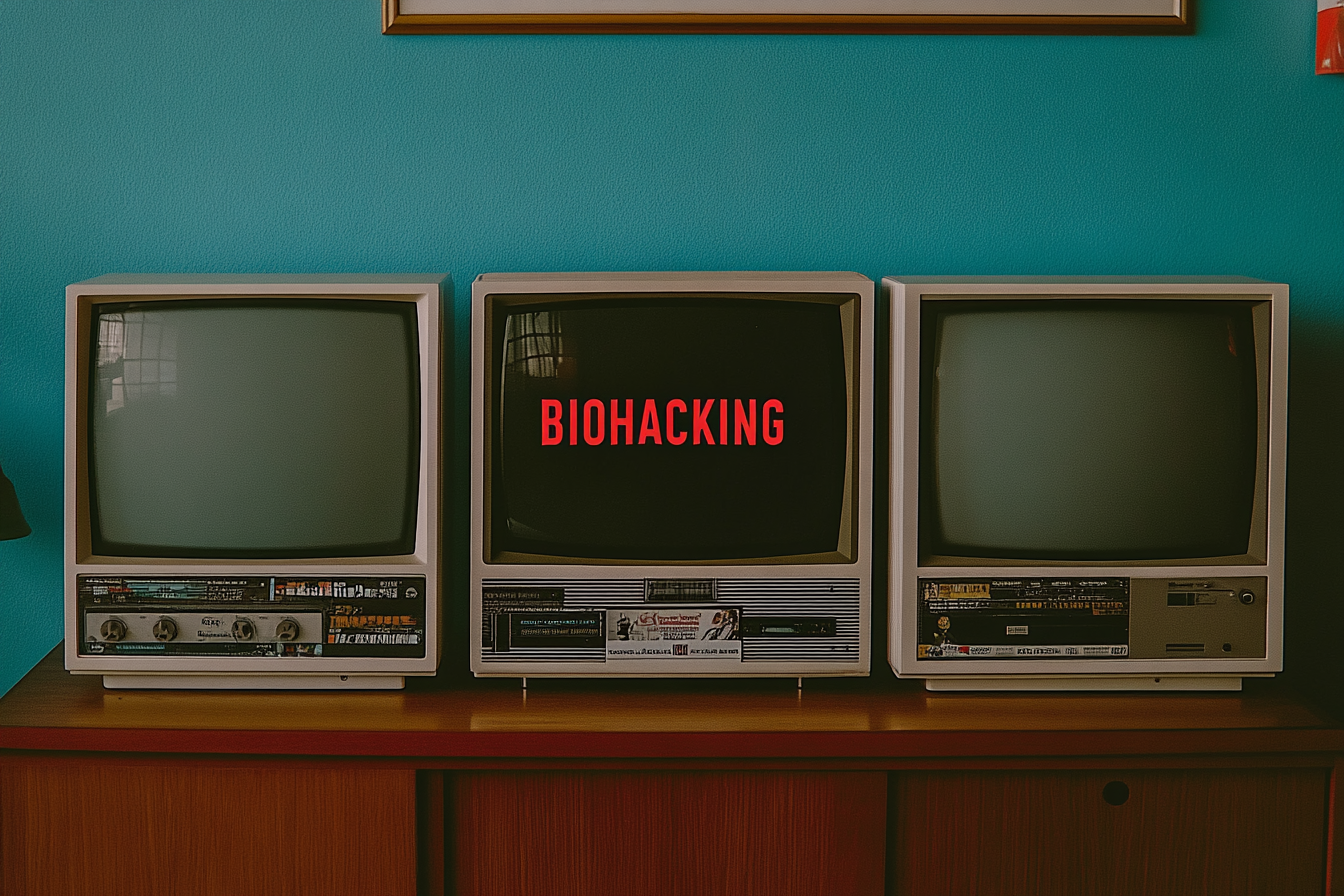
2025: Biohacking Goes Mainstream
Biohacking used more to enhance wellness and lessen disease, regulators grasp at straws, global hubs start to drive innovation and serve new clientele
At the beginning of the year, biohacking as a serious hobby, driving health outcomes is still a niche subculture, despite the growing online presence of biohackers and exploding subscriptions to podcasts discussing different supplement ‘stacks’. Half-way through 2025, Netflix releases a series on ‘Biohacking Health’ which chronicles well-known biohackers and ‘normal’ people who took health into their own hands to cure their ailments and enhance their health. This finally pierces through the noise into the mainstream. Many modes of intervention are cataloged from supplements to off-label/gray-label peptide use to gene therapy to tracking biomarkers through. Hardware such as EEG-based brain monitoring and hyperbaric chambers also are showcased.
This has immediate impacts on supplement suppliers, especially Elysium Health which can’t keep up with demand but still doubles sales YoY after the Netflix special. Public supplement companies see a broader 10-20% increase in market cap from the special.
Hardware companies tracking health also have a boost in sales (wristband heart and sleep monitoring company, Oura, doubles sales overnight). High-tech hardware incumbents such as Apple increase revenue guidance and progresses towards $4.5T market cap as wall street perceives them as a continued winner in the consumer hardware market, which freshly includes the promise of deeper health monitoring. Google, seeing the increased guidance and enthusiasm starts looking for health monitoring companies to acquire, much like their Fitbit acquisition in 2019.
The most measured man alive, Bryan Johnson, uses the Netflix series to expand his current products to a biohacking supermarket, Eternity Grocery. Eternity pilots in LA and is set up across the street from Erewhon, selling everything from high-grade chocolate, olive oil, and AG1 replacements, to fresh superfood produce which is ‘hyper-ganic’. ‘Hyper-ganic’ is a term he coins to account for no pesticides and no plastic (or microplastic) in the growth, watering, processing, shipping, or packaging of the food. Eternity becomes the launch spot for science driven consumer products. As such, Zya, a product which converts sugar to fiber pilots first in Eternity Grocery. This cross-branding and launch sees broader D2C uptake, with people using it in combination with weight-loss peptides.

a counter movement
As the biohacking movement takes off, a counter movement questions proof that the interventions can drive health outcomes for normal people and the long-term consequences of gray-labeled peptides. Grumblings from academics and incumbent biopharma veterans play out mostly on Twitter but some Western-European countries propose legislation to discontinue the sale of gray-labeled peptides. Despite attempts at government crackdown, countries with more socialized healthcare systems have the highest number of biohackers due to long wait times and endless triage in their normal system. Legislation stalls as biohackers sit on both sides of the aisle in 2025.
An explosion of biohacking clubs and communities surge in urban areas and campuses creating a religious zeal typically only seen in running clubs. These biohacking groups share supplements, try peptides together, and generally become a grassroots place for early-stage companies to do customer discovery.
With thousands of people taking greater interventions and monitoring of health, there's a wave of companies which are built to help biohackers aggregate all of their data. For the past year though, there’s been one company which saw this trend coming and started to build, having a more developed feature set and become the de facto app for the movement.
“AI’s ability to scale mental health solutions equitably changes public discourse from mental health to mental enhancement.”
DeepMind releases a functional protein design model, Zyme1, which is able to predict both de novo designs and post-experiment sequence optimization of enzymes. Since the weights weren’t released with the model, open source academic teams design an OpenFold equivalent to Zyme1, named OpenZyme. The model catalyzes an explosion of continuous hormone monitoring applications (estrogen, cortisol, thyroid hormones, and appetite hormones leptin and ghrelin). Other incumbent monitoring startups try to increase the number of hormones monitored by adding new enzymes but the technical debt means that they’re years away from product launch. Startups in the continuous monitoring space, however, build their hardware to multiplex and are able to ship in less than 12 months to alpha users.
QuantifiedSelf DAO creates a decentralized clinical trial which aggregates health outcome, biomarker, genetic, and supplement data to attempt to pair supplement formulations with genetic variation. The readouts of this study in 12 months are loudly anticipated by members of the community and skeptics alike.
Though there is general improvement in AI/ML models in biology (like Zyme1), fully recapitulating a cell is not yet possible. Many groups try to make the Evo model for eukaryotic cells but readouts and experimental validation of model readouts fall short every time. OpenAI’s newest model, GPT-5o is released with training data on all known sequences, including genetic and chemical (with the SMILES database). The model can’t make de novo genomes but can optimize metabolic pathways and can be prompted to make viruses more transmissible. In reaction to readouts, an Executive Order freezes model use temporarily.
Biotir - a biology-focused security company - saves the day to add biological know your customer (KYC) screen to the onboarding process for using GPT-5o. Open AI adds watermarks to the DNA sequences it suggests, which DNA synthesis providers use as a screen for sequences they synthesize (can look at prompt context in which sequence was designed).
Separately, new AI releases and increased cultural emphasis on mental wellness means that AI can now conduct conversational therapy. Incumbent telehealth providers try to layer this into their platform but the product positioning proves too novel and differentiated to wrap into existing UXs, leading to a wave of startups targeting Gen Z users seeking affordable and anytime therapy. With some viral video campaigns on Tiktok, mental health newcomer, TherapAI, is on track to end the year having given digital therapy to 0.1% of the US population.
This proofpoint and AI’s ability to scale mental health solutions equitably changes public discourse from mental health to mental enhancement.

optimization and experimentation
Sleep disorders affect millions of people worldwide in 2025 and are one of the immediately tangible metrics to measure biohacking interventions. As such, new research looking at melatonin receptors finds compounds which increase rapid eye movement (REM) sleep. These molecules are watched intensely as they transition from animal to human studies. Some pioneering biohackers start taking before they start Phase I trials but most wait. Nat Friedman continues to post about galantamine and how it increases his ability to lucid dream. This creates a bona fide craze around galantamine and world-wide shortages occur.

Biohackers have been trying to track and enhance mental acuity for the past years but are only now doing rigorous n-of-1 experiments. This is enabled by non-invasive brain computer interface (BCI) companies. These companies passively record brain activity through an EEG device, integrating insights into the aggregation apps. Biohackers run decentralized clinical trials doing head to head comparisons between Cerebrolysin, Semax, and Selak and various combinations. Initial results show that a combination Cerebrolysin and Semax enhance mental acuity and memory by an astounding 10%.
Despite crackdowns of peptides in some countries, both gray and black market peptide sales skyrocket. Skin peptide company, OneSkin releases clinical data on its second line of peptides + starts to productize, increasing doubling revenues YoY, and reports lower churn rate than other consumer beauty products. Debut Biotech sales of its anti-inflammatory skin cream sees double digit growth MoM.
Metabolic disease continues to be the hottest area of biotech. Phase II clinical trial readouts for implanting islet cells for treatment of Type I diabetes have positive secondary endpoints, reimagining the patient treatment path for patients. Novo Nordisk promptly buys this company, MetabCell for $1bn ($500M upfront) to stay ahead. Third generations of GLP agonists (like retatrutide) are reporting fewer GI side effects (such as nausea). Analysts project this will lead to less churn and more sales in 2026 when retatrutide is approved. This causes Eli Lilly stock to pump and be the first biotech company to cross $1TN in valuation. Both Eli Lilly and Novo Nordisk strike biobucks deals with 10 pre-clinical and early clinical companies which focus on muscle retention.
Multiplexed gene editing and better delivery for gene editing machinery is a tailwind not lost on the biohacking community. In fact, 5% of monogenic gene therapies are now in clinic with 5-10 more therapies approved, primarily in diseases which are caused by point mutations (cystic fibrosis, color blindness, Familial hypercholesterolemia, Haemochromatosis type 1, Tay–Sachs disease). 100 more genetic diseases are currently in preclinical studies, and 100,000 new patients are treated with gene therapy in ‘25.
Minicircle, a plasmid-based gene addition platform, has continued to increase revenues with their follistatin product. There has never been a clinical trial nor data published around the efficacy of the treatment, thus capping how many people use it (<5,000) per year. Minicircle, for the first time, is facing competition in the follistatin space with FolliLife synthesizing a follistatin biologic which can be injected and conduct and publish clinical trial results from their base on Native American reservations. Native American Reservations become a de facto trial hub for biohackers as they don’t have to comply with FDA regulation but are close to US hospitals. Other competitors use cheaper delivery means to input the gene itself into biohackers, though this technology has not yet been tested in humans. Ethical questions start to bubble around wealthy biohackers undergoing treatment on Native American land.

the geopolitics of biohacking
Biohackers trying to understand which states and countries will continue to allow them to enhance their bodies join forces with the rare disease community. As the biohackers learn more about the rare disease community, their need for n-of-1 trials, how treatment speeds can improve outcomes, how much they know about geography-specific treatments, a deep alliance is formed. Many parents of children with rare disease are part of the initial wave of biohackers. As genomic understanding of disease converges with our ability to edit the genome, there is increased interest on both sides of the aisle in letting patients and biohackers alike decide their own therapeutic destiny.
As biohacking fever sweeps the globe in 2025, Dubai positions itself as a futuristic health tourism hub, offering cutting-edge clinics where wealthy individuals can access full-suites of services. Meanwhile, Mexico becomes a hotspot for more adventurous biohackers, with underground labs in Tulum and Mexico City pushing the boundaries of legal and ethical experimentation with cell therapy . Honduras continues to encourage companies like Minicircle to stay as tourism both to see and partake in the biohub bolsters GDP. China, ever the tech competitor, pours massive state funding into AI-driven biotech research, aiming to leapfrog Western advances in continuous hormone monitoring and protein design. The government also implements a controversial social credit system that factors in citizens' health data, incentivizing participation in state-approved biohacking programs.
These global developments create a complex landscape of innovation, regulation, and ethical debates, as each region carves out its niche in the burgeoning biohacking landscape.












